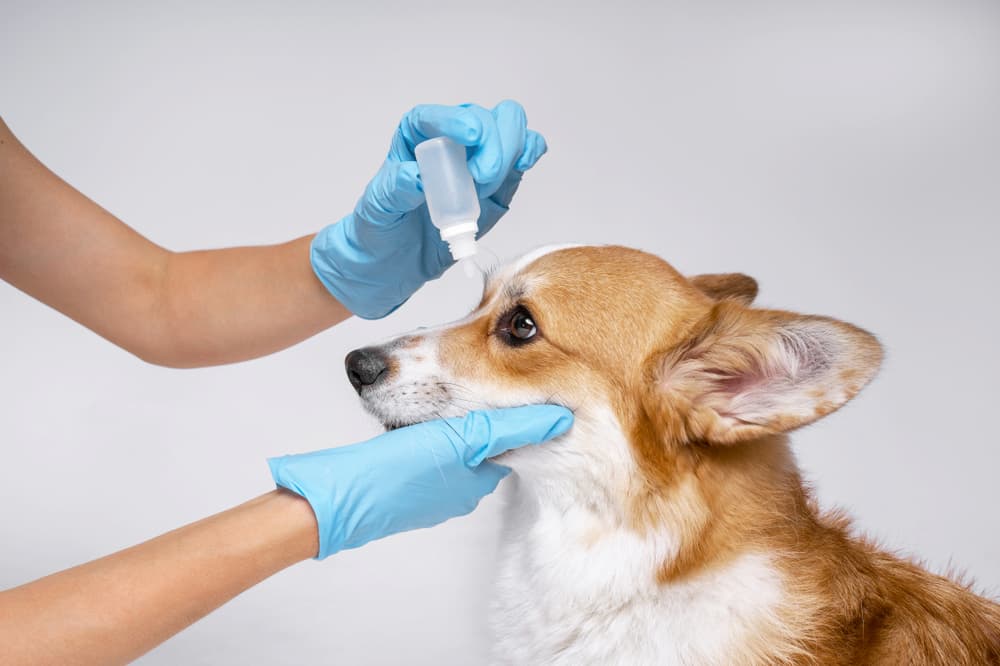Dog Eye Allergies: Symptoms and Treatment Options

Overview
Dog eye allergies are a common issue that can cause discomfort to our canine friends. Like humans, there are things you can do to mitigate their suffering. Keep reading to learn what causes dog eye allergies, and what you can to do help.
What Are Eye Allergies in Dogs?
Eye allergies in dogs, otherwise known as allergic conjunctivitis, is an inflammatory condition. Just like in people, this inflammation is irritating to dogs, causing itchy, red, watery eyes.
Dog eye allergies are often confused with eye infections because they cause similar symptoms and are similarly common. So, how can you spot the difference? Eye allergies are often coupled with other allergy symptoms, such as sneezing or itchy skin. But other key differences between dog eye allergies and infections include:
| Dog Eye Allergy | Dog Eye Infection |
| Eye allergies usually have clear, watery discharge; can also have white discharge | Eye infections have persistent yellow, green, or white eye discharge |
| Eye allergies are only symptomatic when the dog is exposed to the allergen | Eye infections have persistent symptoms |
| Eye allergies often improve with sterile saline eye rinses or antihistamines | Eye infections don’t get better with sterile saline eye rinses or antihistamines |
| Eye allergies may or may not cause squinting | Eye infections often cause dogs to severely squint |
| Eye allergies are often seasonal | Eye infections are random |
| Eye allergies can cause swollen, red eyelids | Eye infections may or may not cause swollen eyelids |
These differences may be subtle and hard to differentiate. Especially if you notice any of these symptoms for the first time, take your dog to the vet as soon as possible. Other red flags include a lack of response to at-home treatments, or more explicit signs of infection like yellow or green discharge.
Causes of Dog Eye Allergies
Believe it or not, dogs can have allergies just like humans. Eye allergies occur when a dog’s immune system has a hypersensitive response to otherwise harmless environmental substances. We call these things allergens, and they can include grass pollen, tree pollen, mold, cat dander, dust, insect particles, and more. When a dog comes into contact with an allergen, their immune system recognizes it as a “foreign invader.” This causes an inflammatory response, resulting in dog eye allergy symptoms. While any dog can develop eye allergies, dogs that have skin allergies tend to have more problems with eye allergies than other dogs.
Eye allergies in dogs can also occur after contacting certain chemicals or eating certain food ingredients. If your dog is sensitive to a particular laundry detergent or after eating chicken, for example, it can cause itchy, red eyes.
Symptoms of Dog Eye Allergies

Dog eye allergies can be simple to spot if you know what you are looking for. If your dog goes outside in the spring or summer and comes back in with red, itchy eyes, you can usually assume it’s eye allergies. Symptoms of eye allergies in dogs can include:
- Acute onset of itchy, red, watery eyes
- Swollen, red eyelids
- Dry eye (keratoconjunctivitis sicca)
- Pawing at eyes
- Rubbing face on carpet or furniture
- Increased eye discharge that may be clear, white, or caked on eyelids
- Yellow or green eye discharge if the eye develops a secondary infection
Remember that dog eye allergies can mimic the symptoms of other more serious eye conditions. This includes conditions like eye infections, glaucoma, eyelash disorders, dry eye, and corneal ulcers. In addition, infectious conditions like distemper or eye worms can cause itchy, red eyes and ocular discharge. If it’s the first time you notice eye symptoms in your dog, go to the vet to rule out other more serious causes of red eyes.
Diagnosing Dog Eye Allergies

Your vet will perform a physical exam, ophthalmic (eye) exam, and other ocular tests to diagnose what’s going on. Your vet will also ask you questions about how long the problem has been going on, if it’s happened before, and if your dog has any problems with skin allergies.
Eye tests your vet may run include staining the eye to look for corneal ulcers, a Schirmer Tear test to check tear production, and tonometry to check pressure inside the eyes to rule out glaucoma. Other tests can include bacterial or viral culture if your vet suspects infection.
Dog Eye Allergy Treatment

If your dog has mild eye allergies, you can often manage the condition at home by rinsing your dog’s eyes with sterile saline any time they become red. While human over-the-counter eye drops may be effective in some dogs, always check with your vet before using any human eye drops on your dog.
If these treatments don’t help, the problem may not be an eye allergy or your dog may need stronger prescription-strength topical medications, like artificial tears. In either case, it’s time to call your vet for advice. Your vet may run more tests, chat with you about food allergies, or prescribe different a medication.
Never use steroid eye drops in your dog without the supervision of a veterinarian. These can cause serious side effects that can result in severe pain and blindness if used inappropriately.
Eye allergies usually clear up on their own when the dog is no longer exposed to the allergen. However, they may appear again in the future if the allergen reappears. Set a reminder in your phone for the same time next year to prevent allergy symptoms before they start.
How to Prevent Dog Eye Allergies
You can minimize your dog’s eye allergy symptoms by applying an eye lube (ask your vet for a product recommendation) before the dog goes outside and then rinsing their eyes with sterile saline after they come back inside. This will remove any allergens from your dog’s eyes. Antihistamines can also be helpful to prevent allergy symptoms in the first place if you start them before symptoms begin. Ask your veterinarian for a type of antihistamine and dosage to use in your dog.
Related Conditions
- Infectious conjunctivitis
- Corneal ulcer
- Atopy
- Food allergy









